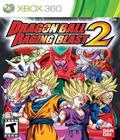"Dragon Ball" pretty much captured everything right and wrong with fighting-based anime in a show that became the defining example of the genre. Its Dragon Ball Z incarnation has been around for almost 20 years, and the series has inspired a small ton of video games by many different developers. A select few have faithfully captured the Dragon Ball style, but others have been less successful.
Traditionally, the Dragon Ball Z: Budokai series has been one of the best implementations of the anime's mechanics and rules, particularly the Tenkaichi subseries. All of the series hallmarks — transformations, fusion techniques and manic surges of fighting — came into play, with decent detail and surprising respect for the lore. It was never perfect, but it was quite satisfying for fans of the show.
Unfortunately, the series has dragged on for a long time. The title changed as it went high-def with Dragon Ball: Burst Limit, which captured most of the essentials, but the follow-up, Raging Blast, was mired in overly complicated controls. The sequel, Dragon Ball: Raging Blast 2, suffers the same issues — sometimes more so than the original title. A beautiful sheen cannot disguise an ugly core in video games, and Raging Blast 2 can't hide behind its graphics, either.
The basic gameplay in Raging Blast 2 is similar to the original title. There are two core buttons, with the other face buttons doing some different, context-sensitive action that may or may not be what you were trying to do. When attacks ask for one of several different types of boost, control is taken away from the player so that he can enjoy an attack cut scene. While this has been a hallmark of Namco's licensed fighting games since Naruto: Ultimate Ninja, the cut scenes have never been enjoyable from a gameplay standpoint, and too often, they feel like punctuation on the fight.
The problem becomes apparent when the player realizes that his hands must move all over the controller to do anything. A combo from basic attacks into a super attack requires a thumb on the right analog stick for one-tenth of a second. Charging ki means getting off the analog stick and using the d-pad. Triggering the signature Raging Blast mode, where your character has unlimited ki and moves extra fast, necessitates tapping the right bumper immediately after charging the ki gauge. The right bumper blocks attacks. Good luck getting any timing right, though, because the game doesn't provide any notification about when a combo times out. Just to make things more difficult, each character and transformation throws a little differently, so memorizing untransformed Goku won't help when he fuses with Vegeta and suddenly has an entirely different set of timings.
Fighting games need to have elegant, easy-to-understand controls, where move variants naturally evolve. A simple dash shouldn't involve a button that also controls rolls based on an arbitrary distance between you and your opponent. Trying to avoid button-mashing by making the controls too complex merely results in an annoying game that's too complex for casual players and not worth the headache for hardcore players.
Raging Blast 2 advertises over 100 playable characters, but there are actually fewer than 70 — half of whom need to be unlocked — plus a limited number of transformations. As with most games of this sort, there are few differences between characters, though there is just enough to throw off your timing and one "signature" move attached to the B button. This nukes any semblance of balance in the game because the best characters have the most transformations, and the team-play rules best suit characters who can use a fusion together. Other characters have fewer options; several characters even have fewer options in their controls, nerfing them further and making the game revolve even more around the series' main characters.
You may not notice if you don't play the game with a friend or online, which works well when you can find an opponent, but the AI likes to resort to cheap shots, is painfully simplistic, and rarely uses techniques that it does well. The AI does not teach good habits for players, even by the low standards of fighting games. A strong move in multiplayer is usually a very bad move in multiplayer; it often means that the computer outpaces the player, especially on the highest difficulties.
The rest of Raging Blast 2 fares little better. There is no story mode, so don't expect to experience the series' plot. Instead, the single-player gameplay is centered on two core modes. Galaxy mode consists of a series of scenarios for each character. The scenarios don't tell the character's story but are a thematic hodgepodge of bits of their tale, combined in a fashion that is only recognizable to someone who knows the plot. For example, Android 18's first scenario pits her against Krillin, with them speaking as husband and wife post-Cell arc, and the second scenario has her fighting Vegeta at the very start of the preceding Android arc. This is confusing from a plot standpoint, but the result produces good difficulty progression and provides a bunch of unlocks.
Scenarios are modestly varied. There are plenty of "beat X" scenarios, but the game favors slight variants to mix up things. The aforementioned fight pitting Android 18 against Vegeta has an auto-refilling super gauge but poisons him, thus allowing stall tactics that would normally be a poor idea. The later Cell fight has Android 18 in Raging Blast mode, but she loses as soon as it times out, requiring you combo down in 20 seconds.
Multiplayer fares decently, with serviceable online play and good split-screen, though there is no penalty whatsoever for quitting in mid-match. Unfortunately, the difficult-to-access basic gameplay means that it doesn't work as well as a party fighter; it's unfortunate that this title killed what used to be the Budokai series' strong point.
The voice acting is from FUNimation's English Dub, for better or worse but has custom dialogue bits to set up fights. The tone is a little less serious than many anime scenarios, with lots of friendly tones to open up fights. Unfortunately, this has the side effect of making the game's screwy position in the plot even more confusing; adjacent matches may jump from the earliest arcs of the series to just before the start of GT, which is completely ignored. This is matched with muted attack sounds and forgettable music.
The presentation is otherwise serviceable. The interface could certainly be sped up, as it takes almost a minute to get into basic matches and in-match play feels like a step down from Burst Limit. Going up to HD has made the game feel less like the Dragon Ball you know and love. All of the details are there, but the models seem lifeless and fail to attain the emotions that they did in Burst Limit.
With bothersome controls and repetitive characters, Dragon Ball Z: Raging Blast 2 falls short at a time when the franchise should be at a high point. The series needs some fundamental reworking if it's going to stand up as well as some of its predecessors, and fans, whether they got into the series during the original run or "Dragon Ball Z Kai," certainly deserve better.
Score: 4.9/10
More articles about Dragon Ball: Raging Blast 2












 Dragon Ball: Raging Blast 2 is the sequel to last year's high-flying, fast-hitting, and intense versus battles series. Dragon Ball Z fans can rest assured that the destructible environment, and character trademark attacks and transformations will be true to the series.
Dragon Ball: Raging Blast 2 is the sequel to last year's high-flying, fast-hitting, and intense versus battles series. Dragon Ball Z fans can rest assured that the destructible environment, and character trademark attacks and transformations will be true to the series.

































